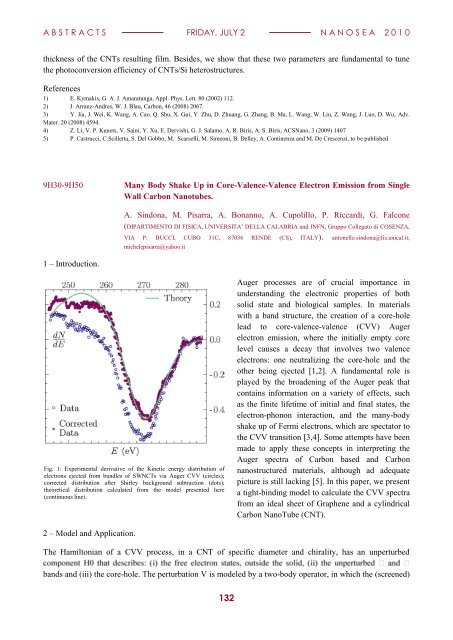book of abstracts - IM2NP
book of abstracts - IM2NP
book of abstracts - IM2NP
You also want an ePaper? Increase the reach of your titles
YUMPU automatically turns print PDFs into web optimized ePapers that Google loves.
A B S T R A C T S FRIDAY, JULY 2 N A N O S E A 2 0 1 0<br />
thickness <strong>of</strong> the CNTs resulting film. Besides, we show that these two parameters are fundamental to tune<br />
the photoconversion efficiency <strong>of</strong> CNTs/Si heterostructures.<br />
References<br />
1) E. Kymakis, G. A. J. Amaratunga, Appl. Phys. Lett. 80 (2002) 112.<br />
2) J. Arranz-Andres, W. J. Blau, Carbon, 46 (2008) 2067.<br />
3) Y. Jia, J. Wei, K. Wang, A. Cao, Q. Shu, X. Gui, Y. Zhu, D. Zhuang, G. Zhang, B. Ma, L. Wang, W. Liu, Z. Wang, J. Luo, D. Wu, Adv.<br />
Mater. 20 (2008) 4594.<br />
4) Z. Li, V. P. Kunets, V. Saini, Y. Xu, E. Dervishi, G. J. Salamo, A. R. Biris, A. S. Biris, ACSNano, 3 (2009) 1407<br />
5) P. Castrucci, C.Scilletta, S. Del Gobbo, M. Scarselli, M. Simeoni, B. Delley, A. Continenza and M. De Crescenzi, to be published<br />
9H30-9H50<br />
Many Body Shake Up in Core-Valence-Valence Electron Emission from Single<br />
Wall Carbon Nanotubes.<br />
A. Sindona, M. Pisarra, A. Bonanno, A. Cupolillo, P. Riccardi, G. Falcone<br />
(DIPARTIMENTO DI FISICA, UNIVERSITA‟ DELLA CALABRIA and INFN, Gruppo Collegato di COSENZA,<br />
VIA P: BUCCI, CUBO 31C, 87036 RENDE (CS), ITALY). antonello.sindona@fis.unical.it;<br />
michelepisarra@yahoo.it<br />
1 – Introduction.<br />
Fig. 1: Experimental derivative <strong>of</strong> the Kinetic energy distribution <strong>of</strong><br />
electrons ejected from bundles <strong>of</strong> SWNCTs via Auger CVV (circles);<br />
corrected distribution after Shirley background subtraction (dots);<br />
theoretical distribution calculated from the model presented here<br />
(continuous line).<br />
Auger processes are <strong>of</strong> crucial importance in<br />
understanding the electronic properties <strong>of</strong> both<br />
solid state and biological samples. In materials<br />
with a band structure, the creation <strong>of</strong> a core-hole<br />
lead to core-valence-valence (CVV) Auger<br />
electron emission, where the initially empty core<br />
level causes a decay that involves two valence<br />
electrons: one neutralizing the core-hole and the<br />
other being ejected [1,2]. A fundamental role is<br />
played by the broadening <strong>of</strong> the Auger peak that<br />
contains information on a variety <strong>of</strong> effects, such<br />
as the finite lifetime <strong>of</strong> initial and final states, the<br />
electron-phonon interaction, and the many-body<br />
shake up <strong>of</strong> Fermi electrons, which are spectator to<br />
the CVV transition [3,4]. Some attempts have been<br />
made to apply these concepts in interpreting the<br />
Auger spectra <strong>of</strong> Carbon based and Carbon<br />
nanostructured materials, although ad adequate<br />
picture is still lacking [5]. In this paper, we present<br />
a tight-binding model to calculate the CVV spectra<br />
from an ideal sheet <strong>of</strong> Graphene and a cylindrical<br />
Carbon NanoTube (CNT).<br />
2 – Model and Application.<br />
The Hamiltonian <strong>of</strong> a CVV process, in a CNT <strong>of</strong> specific diameter and chirality, has an unperturbed<br />
bands and (iii) the core-hole. The perturbation V is modeled by a two-body operator, in which the (screened)<br />
132

















